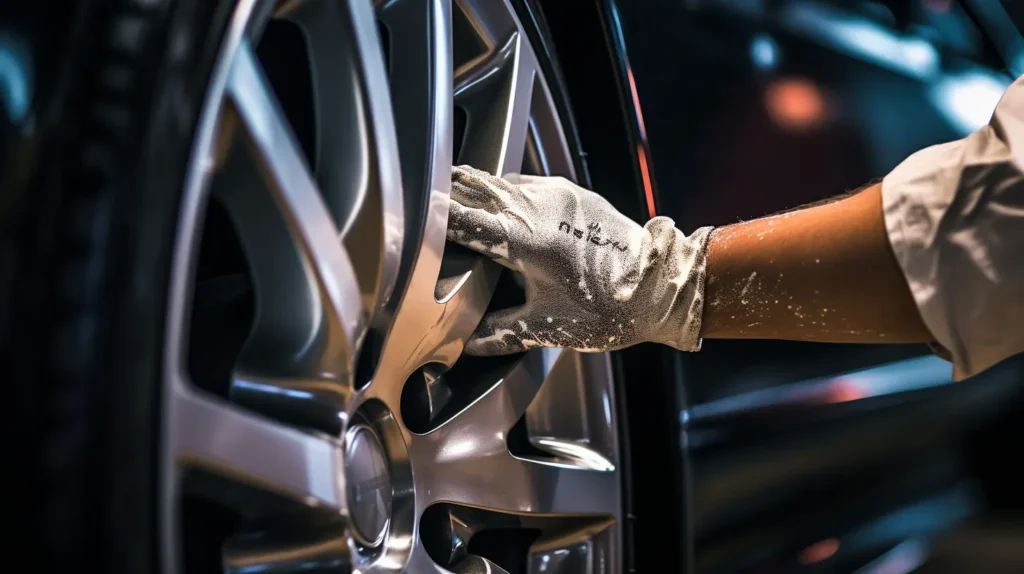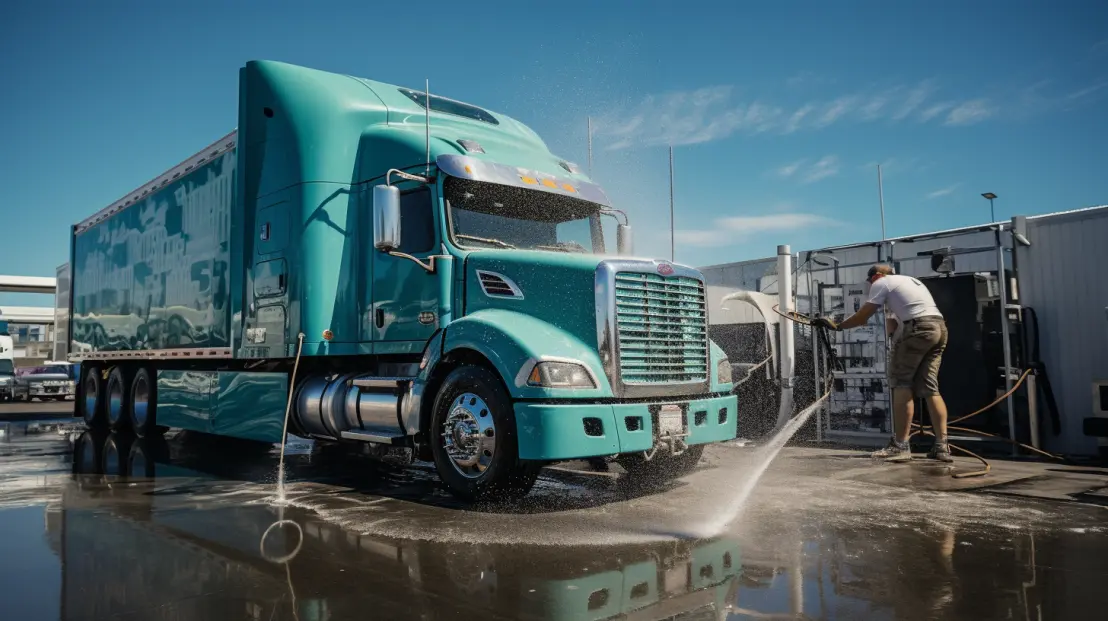When you’re cleaning a dirty truck engine, it’s important to use a high-quality product like SP Cleaning’s Degreaser. Before you begin, make sure to cover delicate parts such as the alternator to protect them from the cleaning solution.
Next, apply the cleaning solution evenly over the engine and let it sit for a bit to work its magic. Then, rinse off the solution thoroughly with cold water. Remember, it’s best to avoid using pressure washers to prevent any damage to the engine components.
After rinsing, take a close look to ensure there’s no leftover residue. Also, make sure to prevent any water from pooling in important areas of the engine.
Before you start the engine again, it’s crucial to let all the components dry completely. This will help ensure optimal performance and prevent any potential issues.
For more tips on how to effectively clean and maintain your truck engine, follow the detailed steps provided in the guide. This way, you can be sure your engine is in top-notch condition for your next drive.
Key Takeaways
- Use SP Cleaning’s Degreaser for safe and effective cleaning.
- Cover sensitive parts and electrical components before cleaning.
- Apply cleaning solution evenly and generously for thorough cleaning.
- Rinse off with cold water, avoiding pressure washers.
- Ensure complete dryness before starting the engine for optimal performance.
1. Use Sp Cleaning’s Degreaser to clean Dirty Truck Engine

When selecting a cleaning product for your truck engine, opt for SP Cleaning’s Degreaser for optimal results.
This product is highly recommended due to its compatibility with engine paint, chrome, and all parts of the vehicle. It’s crucial to confirm the cleaning product is safe to use on all surfaces to prevent any damage.
SP Cleaning’s Degreaser eliminates the need for dilution, making it convenient and ready to use straight out of the container.
Safety precautions are essential when handling cleaning products like Truck wash soap, Pressure washing chemicals, Fleet Washing Chemicals, and aluminum brighteners, and SP Cleaning’s Degreaser is known for heavy duty and its user-friendly nature.
It effectively removes dirt and grime without requiring intense scrubbing, saving both time and effort. The product’s environmental impact is minimal, as it’s formulated to be eco-friendly.
User reviews consistently praise its ability to clean effectively without causing harm to the engine or the environment. Choosing SP Cleaning’s Degreaser ensures a thorough cleaning process while maintaining product safety and environmental consciousness.
2. Preparing the Engine for Cleaning

To prepare the engine for cleaning, it’s important to cover electrical components like the alternator to prevent water damage and make certain the engine is cool before beginning to avoid potential burns or damage.
- Protective Measures:
- Cover the alternator and other electrical components.
- Confirm the engine has cooled down before starting.
- Use a plastic bag to shield sensitive parts from water exposure.
- Avoid using abrasive tools to prevent scratches.
- Perform a visual inspection of the engine for any loose connections or damaged parts.
Inspecting the engine before cleaning is vital to identify any vulnerable areas that need extra protection.
By following these protective measures, including covering electrical parts, waiting for the engine to cool down, shielding sensitive areas, avoiding abrasive tools, and inspecting the engine for any issues beforehand, you can ensure a safe and effective cleaning process without causing any harm to the engine components.
3. Applying the Cleaning Product

Before confirming the engine has cooled down completely to prevent any potential damage, ensure.
When spraying the product, make sure to cover the entire engine compartment evenly for effective results.
Allow the cleaning solution to sit for a few minutes to effectively break down dirt and grime before rinsing thoroughly.
1. Proper Product Application
For optimal outcomes, make sure the cleaning solution is evenly spread throughout the entire engine compartment, covering all surfaces thoroughly. To guarantee the proper application of the cleaning solution, consider the following:
- Use a generous amount of the product for maximum effectiveness in breaking down dirt and grime.
- Avoid spraying directly onto hot surfaces to prevent premature drying.
- Allow the solution to dwell for a few minutes to penetrate and loosen stubborn dirt, making removal easier.
- Apply the solution to all areas, including hidden crevices and corners, for a thorough clean.
- Follow recommended application techniques and safety precautions to optimize cleaning results and save time.
2. Even Coverage Is Key
Applying the cleaning product evenly throughout the engine compartment guarantees thorough and effective removal of dirt and grime, promoting ideal cleaning results. Coverage consistency is vital to make sure uniform application, allowing the cleaning solution to efficiently break down dirt and grime on all engine surfaces.
By applying the product uniformly, you make certain that all parts of the engine receive the necessary treatment for thorough cleaning. It’s important to avoid oversaturating specific areas by maintaining consistent application throughout the engine compartment.
This methodical approach to applying the cleaning product is essential for achieving best cleaning effectiveness, ensuring that your truck engine is thoroughly cleaned and free from built-up grime and dirt.
3. Rinse Thoroughly After Cleaning
To guarantee thorough removal of cleaning product residue and prevent potential damage, it’s crucial to rinse all engine surfaces meticulously after the cleaning process.
- Water pressure: Adjust the nozzle to a gentle spray for effective rinsing without causing damage.
- Drying techniques: Use a clean microfiber cloth to gently pat dry the engine components.
- Check hidden areas: Verify all nooks and crannies are well-rinsed to avoid residue buildup.
- Inspect hard-to-reach spots: Utilize a handheld sprayer for targeted rinsing in tight spaces.
- Final inspection: After rinsing, visually examine the engine to confirm complete removal of the cleaning product.
4. Rinsing Off the Cleaning Product
Using a regular garden hose with cold water is the most effective method for rinsing off the cleaning product from the truck engine. It’s important to avoid using a pressure washer as it can potentially damage sensitive engine components.
When rinsing, make sure that all traces of the cleaning product are thoroughly removed to achieve a clean finish. Before starting the rinsing process, remember to remove any plastic bag covering the alternator to prevent water from getting trapped.
Properly rinse all areas of the engine to prevent any residue buildup, which could lead to issues down the line. This step not only aids in residue removal but also plays a role in engine protection.
Once all the cleaning product has been rinsed off, it’s crucial to think about the next step in the process, which involves drying the engine thoroughly to prevent water spots and promote overall engine health.
5. Drying the Engine Thoroughly
After effectively removing excess water from the engine components using a shop vac or air compressor, the next step is to focus on eliminating any remaining water droplets by wiping down flat surfaces with a clean rag. This guarantees that the drying process is thorough and effective.
To further enhance the drying effectiveness, consider the following steps:
- Heat Application: Utilize a heat source, such as a heat gun or even the warmth from running the engine, to aid in evaporating any remaining moisture.
- Air Compressor: Use an air compressor with a narrow nozzle attachment to blow air across hard-to-reach areas, dislodging and removing trapped water droplets.
- Patience: Allow sufficient time for the engine to air dry completely, making sure that all moisture evaporates before closing the hood.
- Inspection: Conduct a visual inspection to confirm that no water droplets remain on the engine components.
- Final Checks: Before starting the engine, double-check that all surfaces are dry to prevent any potential issues.
6. Final Touches and Drying Completion
I start by meticulously polishing all visible engine components, ensuring a gleaming finish that reflects a job well done.
Next, I meticulously inspect every nook and cranny for cleanliness, making sure no dirt or grime remains.
1. Polishing for Shine
Gently buffing the engine components with a clean microfiber towel enhances the shine and professionalism of the detailing process.
- Use a circular motion to apply light engine dressing for a glossy finish.
- Be cautious not to spray dressing on hot engine parts to avoid damage.
- Detail intricate areas meticulously to achieve a professional look.
- Inspect for any remaining water spots and wipe them off to guarantee a flawless shine.
- Remember to buff gently but firmly to bring out the shine without causing any scratches.
2. Inspecting for Cleanliness
Upon completing the cleaning process, thoroughly inspect all engine areas for any remaining dirt or residue, guaranteeing thorough cleanliness before moving on to the final drying stage.
Check residue by visually examining all surfaces, paying close attention to crevices and component junctions. Address any leftover cleaning product by rinsing those areas with water and a soft brush.
Watch out for water pooling, particularly in areas like valve covers or near the battery. To prevent potential issues, make sure that all components, especially electrical parts, are completely dry before attempting to start the engine.
This detailed inspection guarantees a clean and dry engine, primed for peak performance and longevity.
7. Frequently Asked Questions
1. What Is the Best Way to Clean a Dirty Engine?
When you’re tackling a dirty engine, one of the best methods I’ve come across is using engine degreaser products along with some good old DIY cleaning tricks.
Before you start, make sure to protect any electrical components by covering them up properly. You don’t want any water or cleaning solution causing damage where it shouldn’t!
As you begin spraying the engine degreaser, remember to do so in a gentle and controlled manner. A harsh spray could potentially force water into sensitive areas, leading to more problems down the line. Take your time and ensure the degreaser reaches all the nooks and crannies where grime and grease tend to hide.
Once you’ve let the degreaser work its magic for a bit, it’s time to give your engine a thorough rinse. Grab your hose and make sure the water is cold – using hot water can actually cause more harm than good by expanding metal parts too quickly. Take your time rinsing off all the degreaser and dirt, making sure to leave no residue behind.
After you’ve rinsed everything off, take a step back and admire your handiwork. Your engine should be looking much cleaner and ready to impress. Just remember, regular cleaning and maintenance will help keep your engine running smoothly and looking sharp for miles to come!
2. How Do You Clean a Pickup Truck Engine?
To clean a pickup truck engine, follow these steps:
- Start with a cool engine and open the hood. Spray the entire engine compartment with a degreaser like Simple Green, focusing on the dirtiest areas around the oil filler, head gasket covers, and brake reservoir.
- Let the degreaser sit for 10-15 minutes, then use a rag and old toothbrush to scrub any set-in grease or stains.
- Rinse the engine compartment thoroughly with a garden hose, being careful to avoid spraying directly on electrical components.
- While the engine is still wet, spray the compartment with a rubber and vinyl protectant like Meguiar’s Natural Shine. This will help the engine bay shine and protect against future buildup.1
- Start the engine and let it run for 15-20 minutes. This will help evaporate any remaining water and “steam clean” the engine.
- Wipe down any remaining water puddles or excess protectant with a rag
3. Is It Safe to Spray Your Engine With Water?
Spraying water on your engine can be safe as long as you take some precautions. It’s important to avoid using high pressure water or hot water, as these can cause damage to sensitive engine components. Instead, opt for a gentle spray to avoid any potential issues.
When spraying water on your engine, be mindful of where the water is directed. Avoid spraying directly on electrical components or sensitive parts that could be damaged by water. It’s best to focus on the main surfaces of the engine and avoid getting water into areas where it could cause harm.
Before you start spraying water on your engine, always make sure that the engine is cool to the touch. This will help prevent any sudden temperature changes that could potentially lead to damage. Taking the time to let the engine cool down before spraying water is a simple but important step in ensuring the safety of your engine.
4. Is It Safe to Wash a Truck Engine?
Washing your truck engine safely is important to keep it in good condition. If you’re not sure how to do it properly, it’s best to leave it to the professionals. They have the right tools and knowledge to minimize any risks involved in cleaning your engine.
Before you start cleaning, make sure to cover any sensitive components like the alternator, fuse box, and air intake. This will help protect them from water and cleaning products that could cause damage.
When using an engine degreaser, be sure to follow the manufacturer’s instructions and avoid high-pressure sprays that can force water into sensitive areas. Gentle and controlled application is key to effectively cleaning your engine without causing any harm.
After applying the degreaser, rinse the engine thoroughly with a gentle stream of water. Make sure to remove all traces of the cleaning product to prevent any potential issues.
Once you’ve finished rinsing, allow the engine to dry completely before starting it up again. You can use a gentle stream of air or a clean cloth to help speed up the drying process.
Conclusion
Cleaning a dirty truck engine is kind of like treating it to a spa day after a long haul. By picking out the right cleaning product, getting the engine ready, applying the solution, rinsing it off, and making sure it’s all dried up, you’ll be ensuring that your engine stays in tip-top shape.
As a cleaning chemical manufacturer in Canada, I hope the above article will help you clean your truck engines better
Just like how a well-oiled machine performs better, a clean engine is essential for top performance and longevity. So show your engine some love and keep it running smoothly.



